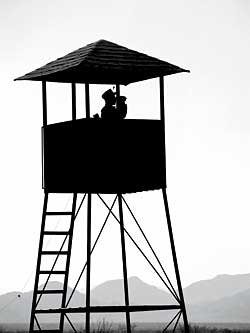
Closing the Loop
Border control, commercial security industry share challenges and solutions
- By Erin Phelps
- Mar 12, 2007
 THE
THE security industry has a long and proud history of working side by side with the government to develop new technologies that result in an improved way of life for Americans. While commercial security products and practices have deep affiliation with both government applications, military and non-military, a new breed of security concerns gave birth to new security requirements and solutions–especially those pertaining to border control.
With more than 185 major airports, 22 major seaports, 7,000 miles of land border and 95,000 miles of shoreline, the United States is a large, vulnerable and porous country. Recent immigration, security and terrorism threats have provoked an unprecedented need for cooperation between private industry and multiple government agencies in to develop and deploy new security technologies that better monitor and alert officials to potential threats along U.S. borders.
In 2006, the Department of Homeland Security received proposals from a number many U.S. government and defense contractors to develop solutions to help protect the country’s borders. The multi-million-dollar proposals submitted included the design, development, system integration, deployment, management and support of what the current U.S. administration calls a "virtual fence" along the nation's land borders.
Sharing Technologies
In addition to assisting government agencies with border control programs, private entities are adopting many military technologies for commercial use. While many security innovations, such as facial recognition, pattern recognition, access control and digital video surveillance, may have debuted in government settings, the technologies also have made their way into everyday life.
Video surveillance has a long history of being very beneficial, starting with the world's first application of close-circuit television during World War II. Military personnel used CCTV technology to monitor testing of the V-2 missile, the first manmade object launched into space. Since then, CCTV has become a security staple in most government installations and applications, including border control. By the 1960s, video surveillance was commercialized and emerged in business and residential environments.
Similar to video surveillance, access control technology also can trace its roots back to the military. It was first designed in the 1960s, specifically for defense use. Physical access control technology has now migrated from military environments to commercial settings. Physical access control systems are now as common in government facilities and military bases as in hospitals, corporate offices, casinos and shopping malls.
While modern video surveillance and access control technologies are much more sophisticated and capable than early ancestors, both remain a mainstay in public and private sector security applications. This is especially true in some of the busiest border crossings in the world.
Supporting Security Investments
In the last decade, despite spending hundreds of millions of dollars, the government's track record has been less than perfect for successfully deploying cutting-edge technology to monitor and protect U.S. borders. Nearly half of video cameras ordered for border control in the late 1990s did not work or were not installed because of poor contract oversight, according to a May 2006 New York Times article. Ground sensors installed along the border frequently sounded false alarms, and communication networks often would not operate for days at a time. Because of the technology and contractor issues, Customs and Border Patrol agents would spend countless hours responding to what turned out to be wild animals, passing trains or other benign nuisances.
So why continue to invest in video surveillance at border access points? The private and public sectors now are working together to create new, more-effective solutions. In fact, recent security advances in the government and commercial sectors are proving to be good investments. Both settings are using an integrated combination of video surveillance and access control, leading to positive results.
Together, video surveillance and access control technologies continue to be the engines that drive most sophisticated and powerful security solutions. When integrated properly, effectively deter and help prevent economic loss while creating safer environments. From border access points and government installations to educational institutions and crowded shopping malls, security tools give officials comfort in knowing electronic physical security technology is in force, monitoring activity, tracking assets, alerting of potential threats and generally protecting people and property.
On any given day in 2005, the CBP used modern security technologies and practices to process 1.2 million travelers, half of whom were aliens; make 60 arrests at ports of entry; apprehend more than 3,000 illegal immigrants; seize 2,000 pounds of narcotics.
The retail industry also relies on security technology to help counteract staggering loss and theft. A few statistics highlight the magnitude of the issue:
• More than $46 billion in goods are stolen annually by shoppers, employees and organized theft rings.
• Nearly $750,000 of a million shoppers and employees were arrested for theft in 2004.
• An average employee theft case is valued at $725.
• Shoplifting is so prevalent that offenders are only caught once every 48 times they steal, according to the National Association for Shoplifting Prevention.
Building from the Ground Up
Through the Secure Border Initiative, the Bush administration has asked private sector defense contractors to devise and build a new border security solution. This approach is a 180-degree change from simply purchasing and installing an array of high-tech equipment—an expensive tactic that has yielded limited success in the past. SBI is lauded as the most significant and industrious effort to control the nation’s borders by the Department of Homeland Security. Learning from past mistakes, SBI is a fresh start in leveraging the combination of technology, infrastructure and manpower to safeguard U.S. borders.
The success of SBI is dependent upon engaging proven security contractors to provide solutions that integrate the expertise, technology and information of both private and government sectors. The winning contract will include some of the same sophisticated security tools already used in U.S. military overseas operations and installations such as motion detection video equipment and ground surveillance systems. The technology should significantly improve the CBP’s ability to effectively monitor the vast areas that separate Mexico and Canada from the United States.
SBI will breed a variety of integrated security technologies necessary to prevent illegal land border crossings and activities. These technologies will include systems, tools and peripherals that have been used successfully by the military: high-tech fences, new patrol roads, access control systems, movable barriers in rural areas, motion sensors, infrared cameras, several varieties of video surveillance or even unmanned aerial vehicles.
Homeland Security Secretary Michael Chertoff said interoperability of technologies used to secure U.S. borders will be the major theme this year. Full integration of all security systems, technologies and practices used by each U.S. government agency will result in better surveillance, tighter controls and comprehensive data collection, storage and sharing. Ultimately, this will lead to a higher level of security at—and within—American borders.
Integration and Cooperation
Integration and interoperability are as critical in the commercial arena as in the government and military sector. From the most simplistic technical perspective, seamless system integration is necessary to maintain tight security. If motion sensors or access control systems do not trigger video monitors, there is a breakdown in overall security.
Even in some of the most competitive industries, the commercial sector has realized the value of sharing information. For example, casinoes track and document suspicious people, and to survive as an industry, it must share data with other casinoes. They use facial recognition technology to capture, archive and share the images of suspected or known scammers in order to collectively protect properties, guests and assets from theft and other threats. In addition to tracking facial identities, casinoes also monitor financial records, hotel reservations, behaviors and gambling patterns to proactively identify, document and report suspicious trends.
In terms of the government sector, the United States has several existing means to protect and secure the country: physical barriers, manpower and technology. However, effective border protection also necessitates development and use of business processes and standardized policies and protocols, allowing for consistency and the seamless exchange of information. Successful security initiatives at borders require a combination of the factors.
To accomplish goals of the SBI, the government and security system manufacturers around the world will need to cooperate like never before. Only through a collective vision, common goals and spirit of cooperation will all parties be able to provide all U.S. national security agents, including those on land, air and sea, with the tools to successfully prevent illegal entry and exit of people and contraband through American borders. This should include nationwide information sharing, credentialing, identity management and biometrics, as well as the ability to conduct rapid searches and identification on suspicious and detained individuals.
Opportunities Abound
The multi-billion-dollar SBI contract, along with numerous DHS grants funded by port and transportation security contracts, will keep the security industry’s top manufacturers, dealers and integrators busy for years to come. While the work can be attributed to the unfortunate risks and threats that the nation must face in today’s environment, including the indefatigable flow of immigrants and mounting terrorist threats, the significant majority of work will result from the priority on interoperability and convergence among technologies.
With this in mind, the focus will be on building scalable, interoperable and fully integrated security solutions. It will not be enough to introduce standalone technology—no matter how cutting-edge it might be—if it is not compatible with other security components and systems involved in the initiative. The SBI contract also creates huge opportunities for information technology and networking integrators needed to ensure systems are communicating with one another; put systems in place for proper data storage and archiving; and ensure government agencies can quickly and effectively add, update and share data.
In September 2006, Boeing Corp. won the award to assist CBP with providing the most appropriate and effective security solutions tailored to each border environment. Under that contract, Boeing is accountable to drive new standards for security system integration, public-private industry cooperation and technological innovation.
Border control solutions will likely use technology, including sensors, thermal imagery, remote cameras, improved communications or other technologies, along with new or improved infrastructure such as roads, bridges, fences and lighting, depending on the needs of the entry location. The agency’s holistic expectation is that its border control personnel will be able to identify a person or item at entry, readily classify its threat, provide a means to efficiently respond to the entry, and bring the entry, expediently to the appropriate law enforcement resolution.
With security risks mounting and a collective commitment to improve border control efficiency and effectiveness, SBI will be an ideal platform for all security manufacturers, dealers and integrators to potentially impact change in industry practices and foster innovation in both public and private sectors.